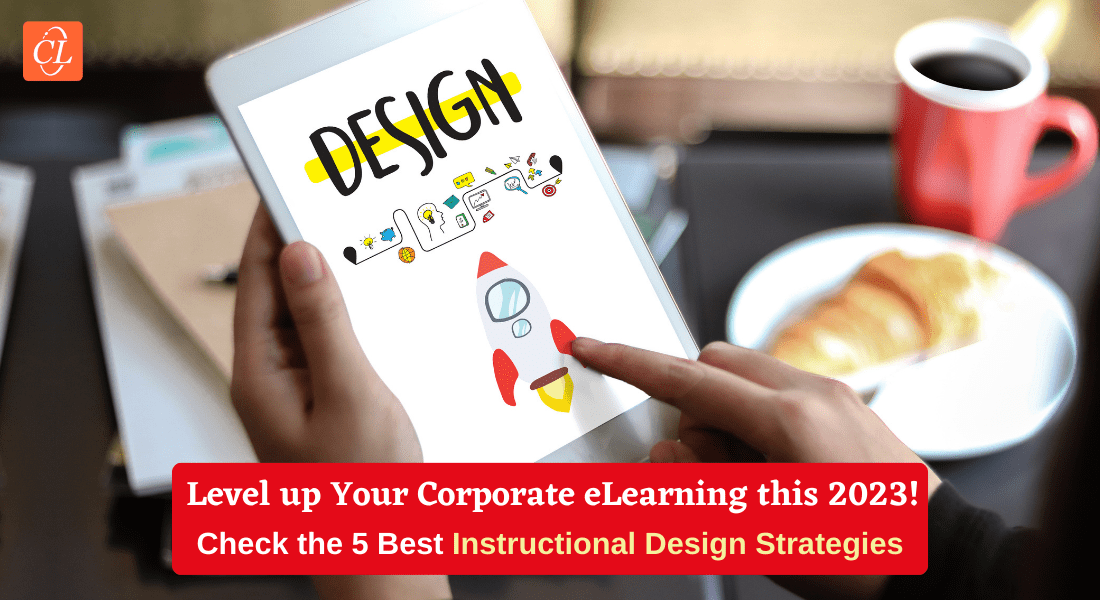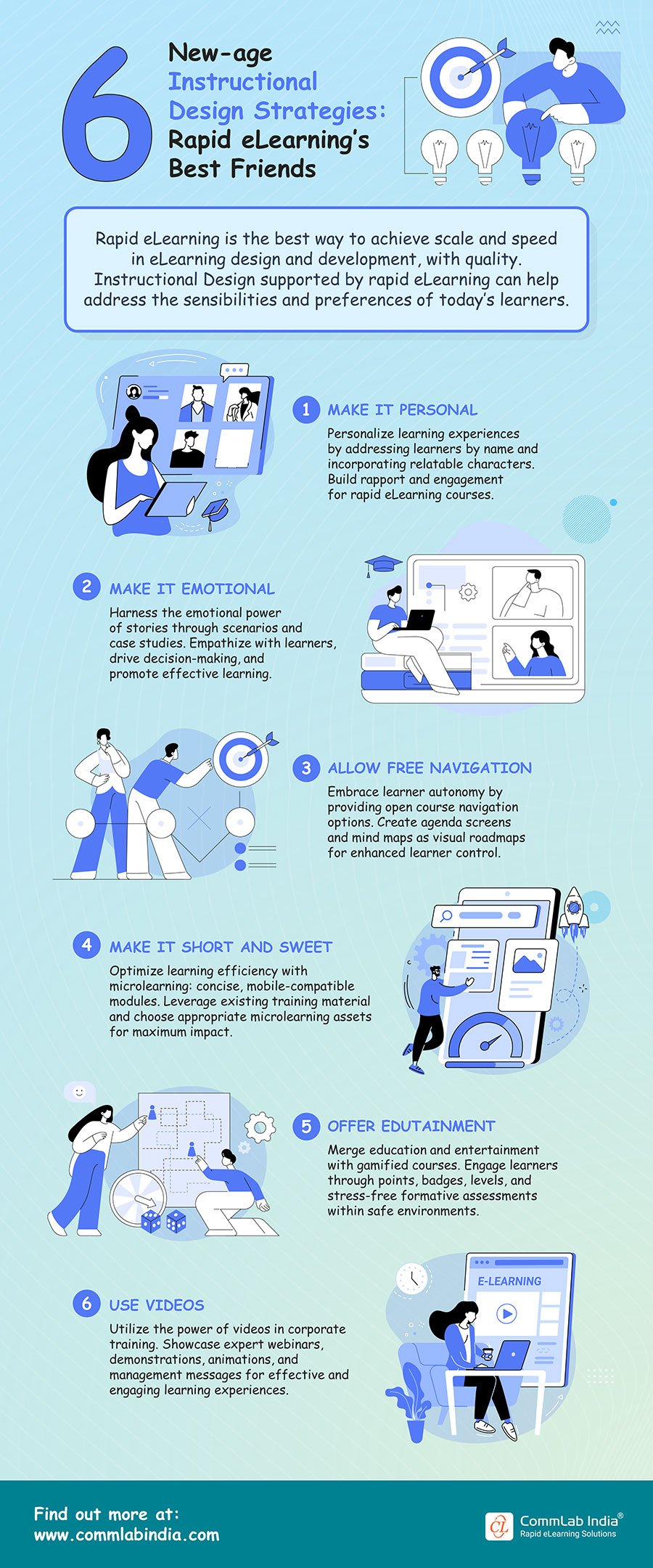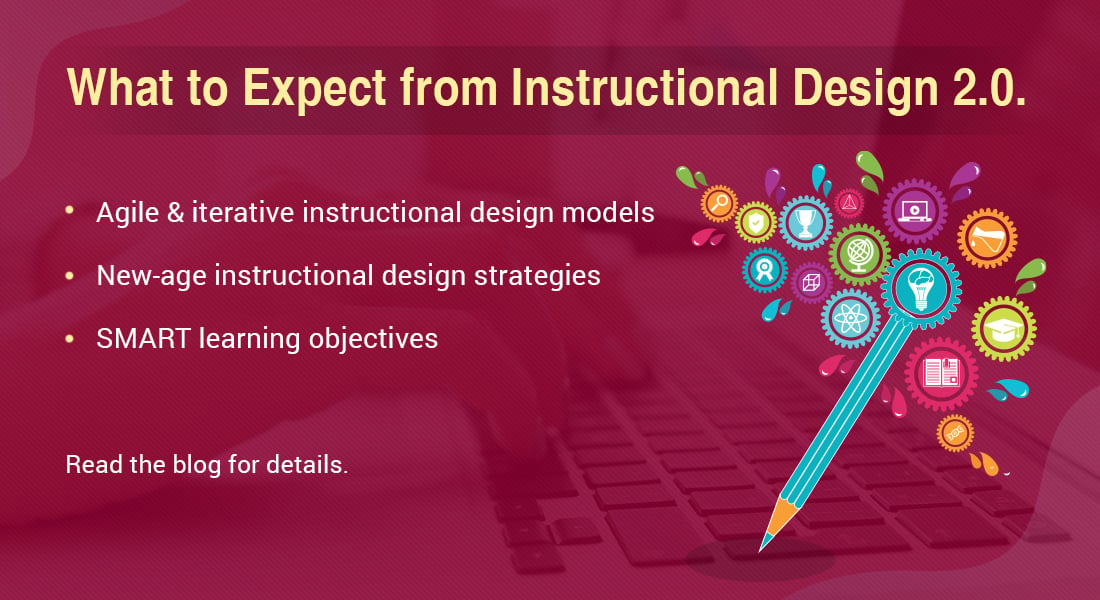5 Best Instructional Design Strategies for 2023 to Level up Your eLearning Courses

Learning without an effective outcome is a futile venture. And to ensure productive and desirable results, organizations need to focus on designing eLearning courses that are interactive, immersive, and engaging. Well, if only it was so easy. In fact, designing and developing learner-centric eLearning courses is what most organizations struggle with. So how can you overcome this challenge? The answer is — by leveraging instructional design strategies.With the help of right instructional design strategies, you can ensure that the eLearning courses are effective, engaging, and at the same time replete with the relevant and necessary knowledge. All these elements enable learners to attain the learning objectives in a successful manner.
Say Cheers to 2023 by Designing Effective eLearning Courses!
Incorporate these instructional design strategies to do so:
- Scenario-based learning
- Storytelling
- Microlearning
- Gamification
- Simulation
Instructional design strategies covers the aspect of how information will be conveyed to learners in order to maximize the learning and the training ROI. So, they cater to adult learning principles, such as self-direction, value addition, etc. By integrating different learning formats and eLearning interactivities, instructional design strategies cater to varied learning preferences and styles that boost learner engagement and initiate participation.
Instructional design strategies are a timeless concept, but which strategies rule the training industry varies with learner habits and business objectives. So which instructional design strategies are all set to lead the eLearning industry for the upcoming 2023? Let’s find out!
5 Instructional Design Strategies Walking Strong into 2023
Scenario-based learning
Let’s suppose you are in 2023 and you want to design an effective eLearning course. What would you do? Stick with the same traditional instructional design strategies to expect the same results. Or level up with innovative, modern instructional design strategies to explore new possibilities to make learning fun and engaging? Well, that’s just a scenario!
Scenario-based learning is highly effective when you want to train your employees on actual work-related things. In this approach, the learners are given a situation or scenarios where they are expected to make decisions or perform a task to reach a certain outcome. It includes different elements like a creative storyline, characters, and questions that have multiple possibilities. Eventually, all these elements can be analyzed, and the learner can be guided in the right direction by providing them with comprehensive feedback.
Here the learners need to understand which outcome is the best. It also helps them gain confidence in real-life work situations as they get close experience in tackling tricky situations during the training. Scenario-based learning boosts employees' critical thinking and problem-solving skills, along with the ability to make timely decisions. Leveraging scenario-based learning to provide your employees with leadership training, compliance training, soft skills training, etc., can come in handy. It makes the learning experience more relevant, relatable, and experiential which will prepare them to circumvent unforeseen situations in 2023 without taking a toll on their personal or professional life.
→ Download Now: Instructional Design 101
Storytelling
It is a great method to augment your eLearning courses. It includes transferring knowledge by sharing different scenarios, anecdotes, case studies, or even some personal experiences that help learners understand the implications (which can be either positive or negative) of a certain action or decision. This approach provides a holistic context and insight to learners about various situations they are most likely to come across in the organization and their respective roles. The outcomes shared via storytelling act as a guiding lamp for the learners to act and behave in a certain manner.
You can use the storytelling approach to make your employees familiar and well-versed with organizational culture, values, and the management system. It helps the employees have a fair idea about what is expected from them, form opinions, and develop a certain mindset and work ethic that aligns well with these requirements. Therefore, to provide your employees with tacit knowledge and train them on some actionable topics involved in their day-to-day work-life, incorporating storytelling in your instructional design strategy should be your go-to strategy. Also, storytelling is a viable method if you wish to train your employees on behavioral aspects and bring about positive behavior changes.
So whether it’s 2022 or 2023 or for that matter 2030, whether it’s Gen X, Millennials, or Gen Z, the charm and effectiveness of storytelling never gets old. It taps into the emotional, deep-rooted connection between humans and narratives that has been established over the ages making the whole learning experience special and memorable. Are you ready to write your success story? You can even take it step further by using artificial intelligence (AI) for instructional design. Check out the video below to know how.
Microlearning
Do your learners lose interest in training because the courses are too lengthy? Or do they struggle to recall information that was said somewhere between the session without proper emphasis? Well, microlearning is one method that handles such problems efficiently and also your preferred approach for the year 2023. In this strategy, the information is provided to the learner in small nuggets, which makes it easier for them to pay attention. Microlearning covers a single learning objective which enables easy reinforcement of the information.
It also makes sure that the courses are interactive and engaging as it includes various microlearning assets like audio, video, animation, GIFs, infographics, etc. Usually, a microlearning video ranges from 5-15 minutes, so it doesn’t expect the learner to set aside a special time for learning which can be overwhelming when they are already struggling with narrow deadlines.
Even better, as the information is provided in micro units, it offers a better chance for the learners to implement this information in a real-life situation, which makes it more useful and easy to remember. With all these benefits, microlearning is one of the best approaches to follow in 2023. It helps you curtail new-age challenges of reduced attention spans, distractions, time crunch, etc.
With that said, if you’re planning to go global in 2023, it will enable you to attend to your international workforce as microlearning courses can be accessed at any time and from anywhere. Moreover, you can easily update the training material, leverage content to provide just-in-time information, performance support, etc. So if you want your employees to make the best of 2023, microlearning is definitely worth considering.
Gamification
Gamification has been a buzz word in the world of corporate training lately. Its effectiveness as an instructional design strategy stems from the fact that it attends to the basic human nature of competing, learning, and achieving. Furthermore, it takes away the stress part and induces the element of fun and excitement that makes learning experience more immersive and engaging. The concept of gamification refers to the application of gaming elements to non-game scenarios.
It includes two aspects, and they are game mechanics and game dynamics. Game dynamics are the factors that instigate a response from the learner and motivate them to participate. It taps into the human psyche that loves challenges. On the other hand, game mechanics deals with the aesthetic and design element of the eLearning course, which makes the learning experience immersive and user-friendly. This includes points, levels, badges, leaderboards, etc.
Gamification fosters cooperation, collaboration, self-analysis, accountability, team-building, and more. Moreover, with Millennials and Gen Z (for whom games = video or computer games and happiness = PS5) forming a significant part of today’s workforce, gamification is definitely worth the hype and a try! So, in 2023, give your employees a reason to learn because it’s fun!
The idea of edutainment in instructional design is fairly modern. But rapid eLearning supports modern instructional design strategies to achieve scale and speed with uncompromised quality. Here’s an infographic to give you an idea.

Simulation
The future is here! Well, at least next year is. And simulation has been at its best to ensure an augmented, hands-on learning experience in corporate training. It refers to the immersive technique where the learners are presented with situations that replicate real-life scenarios. Simulation facilitates skill and knowledge development in an interactive and engaging manner as the employees or learners get to experience the context and information like they are already there.
Simulation caters to all their senses which improves retention and recall, thereby fostering a better understanding and decision-making ability. It also encourages the employees to go ahead with their decisions and take calculative risks without having any detrimental impact. Therefore, simulation offers experiential learning without being heavy on the pocket. You can use it to train your employees on various processes, strategies, technology, risk analysis, etc.
The learners can practice as many times as they want until and unless they are thorough and confident in the application of the concept. This improves their level of comfort in handling new machinery, situations, etc., which augments their performance and productivity. As we know that learning something hands-on is always more effective and impactful than simply reading about it. New-age employees and their learning styles are no different! Therefore, you should incorporate simulation in your instructional design strategies for 2023 to provide your employees with experiential learning.
Wrapping It Up!
New year brings new hope! We all wish to make the best of what is to come. Striving for effective learning outcomes and maximizing training ROI for the year 2023 is no exception. So looking for instructional design strategies that make your training efforts worthwhile is definitely a great start toward a productive and successful year. They are sure to offer you an edge in the ever-evolving, fast-paced L&D industry! If you need some guidance on how to design the best-in-class eLearning courses, here’s a handy, all-encompassing instructional design guide for you. Check it out now!





